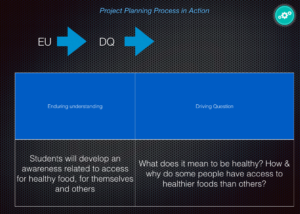Interested in diving into project based learning? Check out our self-paced tutorial on Project Based Learning: PBL in your PJs. You may also like our posts on PBL featured by Getting Smart, in addition to this great resource, where CraftED’s very own Jenny Pieratt is quoted! Missed our last PBL post featured by Crafted on October 17th on planning for authenticity in PBL? Then read below for some good tips for getting started:
Authenticity in PBL
Authenticity is truly the bedrock of planning high quality projects. In my my recent PBL posts I provided an invitation for getting started with PBL by identifying a working definition for high-quality projects, or a “north star”. While there are a variety of definitions for quality PBL, a common thread throughout these definitions is always an element of real-world connection, or authenticity. To learn more about authenticity I highly recommend this blog by John Larmer from BIE.
Getting Started
- Start with Enduring Understanding
I recommend identifying what you want students to learn and remember 15 years from now. This element of timeless learning across contexts requires identifying content deeply grounded in a discipline and an aligned driving question. Here is where you bring in your standards, but more importantly, you also want to think about WHY this content is important for students to learn-what is happening in the real world that could connect to this content?
*For help with establishing your Driving Question check out the Question Formulation Technique by The Right Question Institute
- Identify an audience
Once you have landed on the “why” (and possibly even the “how) for what students will be learning you will want to consider the “who”. With whom will students be sharing their learning? Who would benefit from learning the information students are about to explore (beyond the walls of your school)? or who needs benefit from our learning in some way? This element of authenticity is critical to 1) raising the stakes for student work 2) creating relevance in learning , and 3) building empathy in students to ensure deeper learning. For more on entry points for building empathy read this post.
Another layer to a authenticity is thinking about who you may bring into the project process. In other words, who may be an expert in this field that could provide feedback for student work? To help you think through this check out CrafTED’s planning-real-world-work and teaching materials on real-world exploration.
- Envision a showcase
Now that you have a real-world audience in mind you will need to decide on the best way to share student learning with them. Jeff Robin of High Tech High once gave me the most harsh, yet lasting feedback on final products when he said (with passion), projects are 1) not poster board presentations and 2) not to be curated as white paper with blue tape. Now your first project won’t be the caliber of work from folks like Jeff, it may be something smaller like an infographic to share with the community, like this CraftED community member. Infographics in fact providea great deal of authenticity, so long as an intended audience is in mind. For more on this check out CraftED’s post on infographics, authentic and deeper learning on info.gram. For exhibition inspiration view these videos from HTH. And for more ideas on disseminating student work visit CraftED’s pinterest board.
If you read this far, gold star for you! AND this planning tool by CraftED to help you think through this process of identifying authenticity in your project. Want to bring CraftED to your school to dive into authentic Project Based Learning and other Deeper Learning practices? Contact jenny@craftedcurricu.staging.wpengine.com to find out more.

